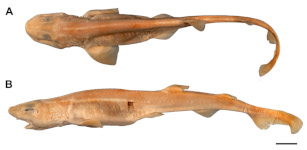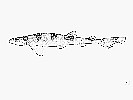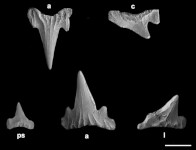Scyliorhinus torrei
Howell Rivero, 1936
Dwarf catshark
Classification: Elasmobranchii Carcharhiniformes Scyliorhinidae
Reference of the original description
Some new, rare and little-known fishes from Cuba. Proceedings of the Boston Society of Natural History, 41, 41–76
Some new, rare and little-known fishes from Cuba. Proceedings of the Boston Society of Natural History, 41, 41–76
Image of the original description
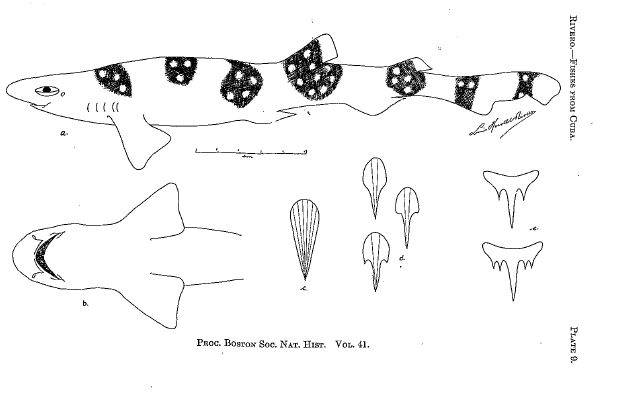
Scyliorhinus torrei Howell Rivero, 1936, Holotype, female, M.C.Z. 1457, Havana, (Howell Rivero 1936, Pl. 9)

Scyliorhinus torrei Howell Rivero, 1936, Holotype, female, M.C.Z. 1457, Havana, (Howell Rivero 1936, Pl. 9)
Description :
Citation: Scyliorhinus torrei Howell Rivero, 1936: In: Database of modern sharks, rays and chimaeras, www.shark-references.com, World Wide Web electronic publication, Version 12/2025
Please send your images of "Scyliorhinus torrei" to info@shark-references.com
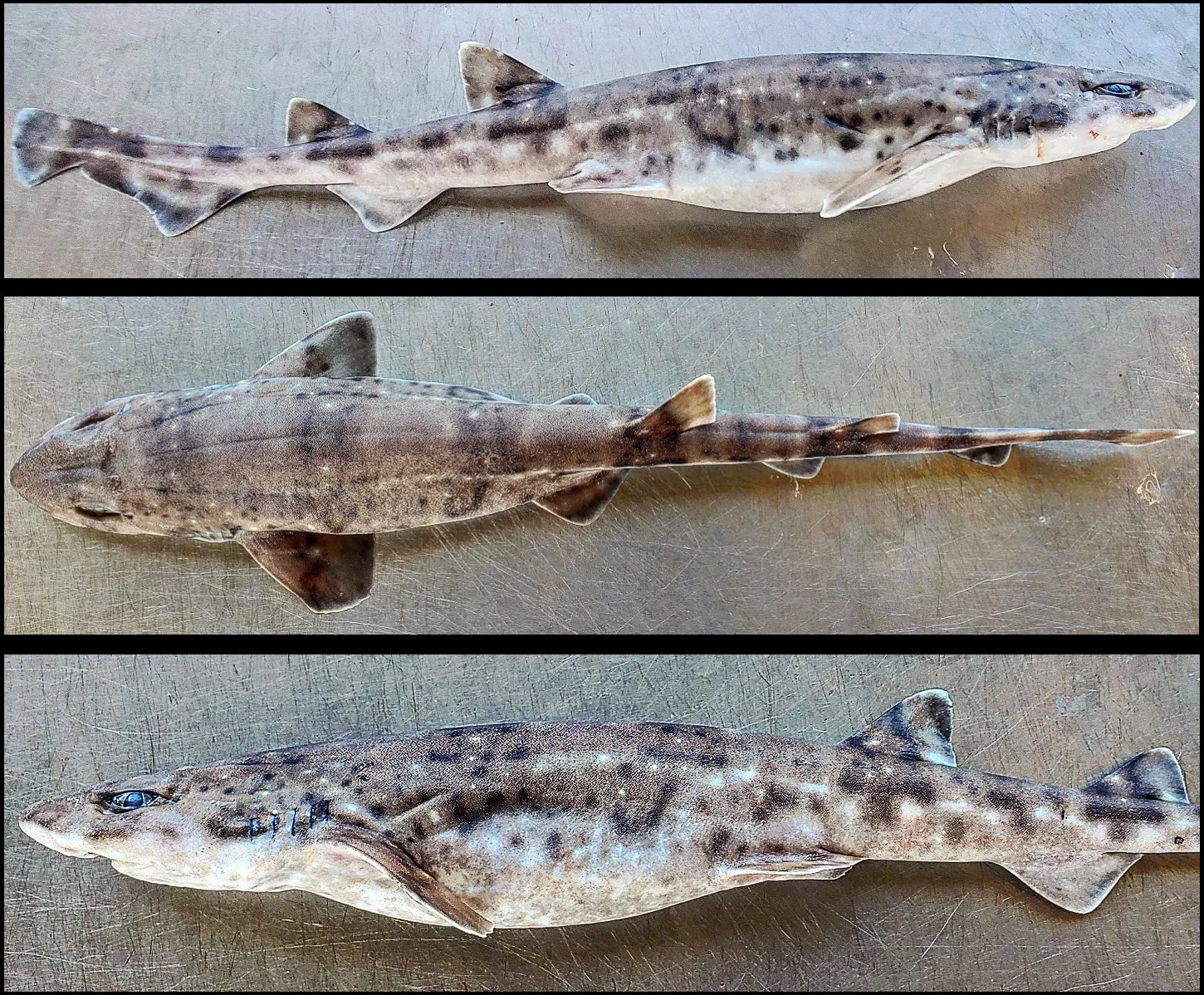
Scyliorhinus torrei Howell Rivero, 1936, 35cm TL, female, caught at 490m off Rincon, Puerto Rico © Rodolfo Abrams courtesy of Conservación ConCiencia

Scyliorhinus torrei Howell Rivero, 1936, 35cm TL, female, caught at 490m off Rincon, Puerto Rico © Rodolfo Abrams courtesy of Conservación ConCiencia
Common names
 Alitán enano,
Alitán enano,  Gatica,
Gatica,  Gatica prieta,
Gatica prieta,  Roussette naine,
Roussette naine,  Cat shark,
Cat shark,  Dwarf Catshark,
Dwarf Catshark,  Dwarf cat shark
Dwarf cat shark
 Alitán enano,
Alitán enano,  Gatica,
Gatica,  Gatica prieta,
Gatica prieta,  Roussette naine,
Roussette naine,  Cat shark,
Cat shark,  Dwarf Catshark,
Dwarf Catshark,  Dwarf cat shark
Dwarf cat shark
Short Description
Diagnosis after Compagno, 1984 [517]: Field Marks : A dwarf, slender, brown and obscurely-saddled catshark with large white spots uniformly covering dorsal surface, small anterior nasal flaps that do not reach mouth, no nasoral grooves, labial furrows on lower jaw only, second dorsal fin much smaller than first. Diagnostic Features : Head and body relatively deep, slender and narrow. Greatest width of head about 2/3 of head length; no nasoral grooves; anterior nasal flaps not expanded and falling just short of mouth. First dorsal origin opposite or somewhat behind pelvic insertions; second dorsal origin opposite or behind anal insertion; interdorsal space considerably greater than anal base; claspers without hooks on exorhipidion. Denticles small and flat, surface of skin relatively smooth. Colour pattern of 7 or 8 brown, obscure saddles on a light brown background and numerous large, regularly scattered white spots on dorsal surface; no black spots. Monospondylous precaudal centra 30 to 34. A dwarf species, adults 32 cm and below.
Diagnosis after Compagno, 1984 [517]: Field Marks : A dwarf, slender, brown and obscurely-saddled catshark with large white spots uniformly covering dorsal surface, small anterior nasal flaps that do not reach mouth, no nasoral grooves, labial furrows on lower jaw only, second dorsal fin much smaller than first. Diagnostic Features : Head and body relatively deep, slender and narrow. Greatest width of head about 2/3 of head length; no nasoral grooves; anterior nasal flaps not expanded and falling just short of mouth. First dorsal origin opposite or somewhat behind pelvic insertions; second dorsal origin opposite or behind anal insertion; interdorsal space considerably greater than anal base; claspers without hooks on exorhipidion. Denticles small and flat, surface of skin relatively smooth. Colour pattern of 7 or 8 brown, obscure saddles on a light brown background and numerous large, regularly scattered white spots on dorsal surface; no black spots. Monospondylous precaudal centra 30 to 34. A dwarf species, adults 32 cm and below.
Distribution
around the southeastern coast of Florida and eastern Florida Strait (28ºN), off western Bahamas, from Havana to Sancti Spiritus, northern Cuba, and in the Virgin Islands and Playa Santa, Porto Rico [27296] Source: www.gbif.org
around the southeastern coast of Florida and eastern Florida Strait (28ºN), off western Bahamas, from Havana to Sancti Spiritus, northern Cuba, and in the Virgin Islands and Playa Santa, Porto Rico [27296] Source: www.gbif.org
Human uses
fisheries: of no interest
fisheries: of no interest
Dentition
Monognathic heterodonty gradual well developed; anterior teeth abruptly larger than the parasymphysial ones and lateral teeth smaller distally, with smaller and thicker principal cusps (Fig. 89). Sexual heterodonty not observed; only adult males examined. Tooth counts 16–21 17–21/15–20 1 15–21 (21–21/20–1–20). Parasymphysial teeth with a principal cusp flanked by one cusplet on each side; cusplets 2/3 the width of the principal cusp. Protuberances on medial portion of the crown base and striae restricted to the crown base. Anterior teeth larger than the parasymphysial and principal cusp less stout. Anterior teeth with two to four cusplets; marginal cusplets when present in upper teeth less developed than in lower ones. Proximal cusplets shorter, half or less the height of the principal cusp in upper teeth and more than half the height in lower ones. Protuberances on the crown base; striae extending through almost the entire crown and more prominent in upper teeth. Lateral teeth with three cusplets; two cusplets at the mesial edge and one at the distal edge. Mesial proximal and distal cusplets corresponding to half the height of the principal cusp; marginal cusplet half the height of proximal one. Protuberances inconspicuous; striae restricted to the crown base. Commissural teeth with one cusplet; principal cusp stouter and laterally situated. Cusplet 2/3 the height and half the width of the principal cusp. Protuberances on the crown base and striae throughout the crown. Ectodermal pits present in lateral and commissural teeth, restricted to the crown base. [27296]
Monognathic heterodonty gradual well developed; anterior teeth abruptly larger than the parasymphysial ones and lateral teeth smaller distally, with smaller and thicker principal cusps (Fig. 89). Sexual heterodonty not observed; only adult males examined. Tooth counts 16–21 17–21/15–20 1 15–21 (21–21/20–1–20). Parasymphysial teeth with a principal cusp flanked by one cusplet on each side; cusplets 2/3 the width of the principal cusp. Protuberances on medial portion of the crown base and striae restricted to the crown base. Anterior teeth larger than the parasymphysial and principal cusp less stout. Anterior teeth with two to four cusplets; marginal cusplets when present in upper teeth less developed than in lower ones. Proximal cusplets shorter, half or less the height of the principal cusp in upper teeth and more than half the height in lower ones. Protuberances on the crown base; striae extending through almost the entire crown and more prominent in upper teeth. Lateral teeth with three cusplets; two cusplets at the mesial edge and one at the distal edge. Mesial proximal and distal cusplets corresponding to half the height of the principal cusp; marginal cusplet half the height of proximal one. Protuberances inconspicuous; striae restricted to the crown base. Commissural teeth with one cusplet; principal cusp stouter and laterally situated. Cusplet 2/3 the height and half the width of the principal cusp. Protuberances on the crown base and striae throughout the crown. Ectodermal pits present in lateral and commissural teeth, restricted to the crown base. [27296]
Remarks
shark-references Species-ID=6370;
shark-references Species-ID=6370;









